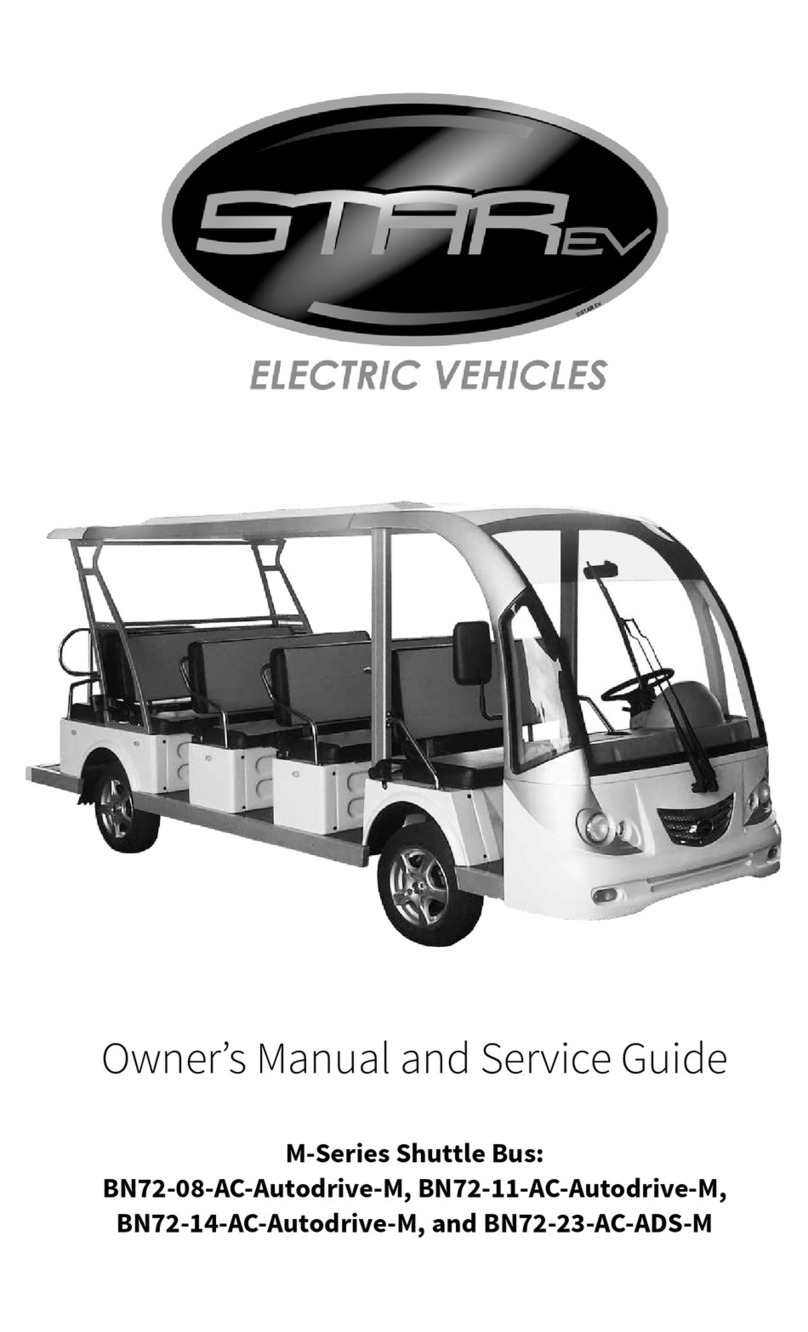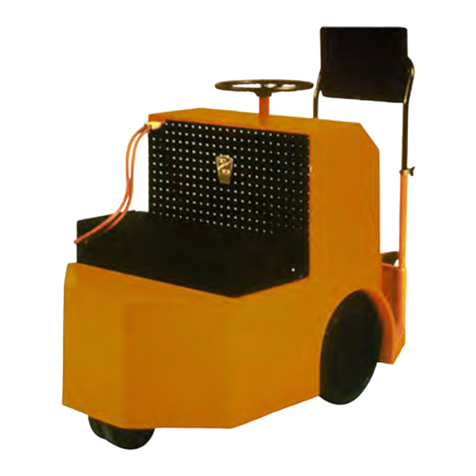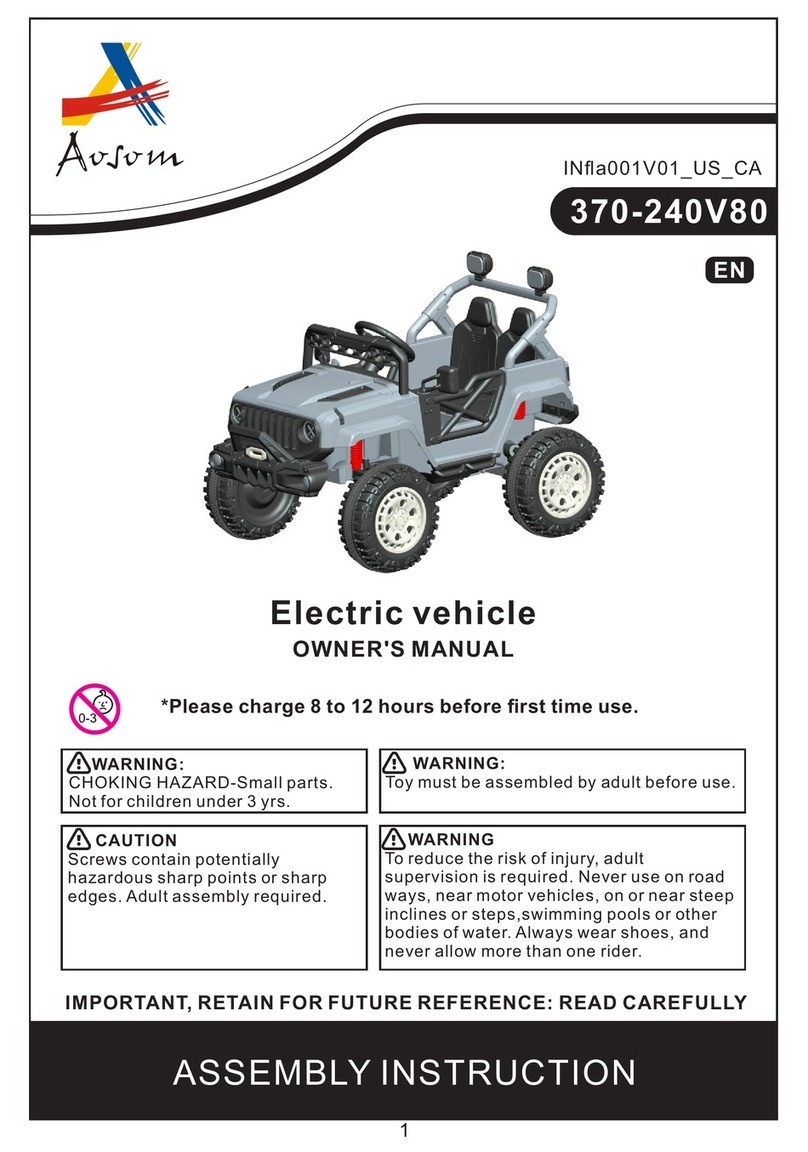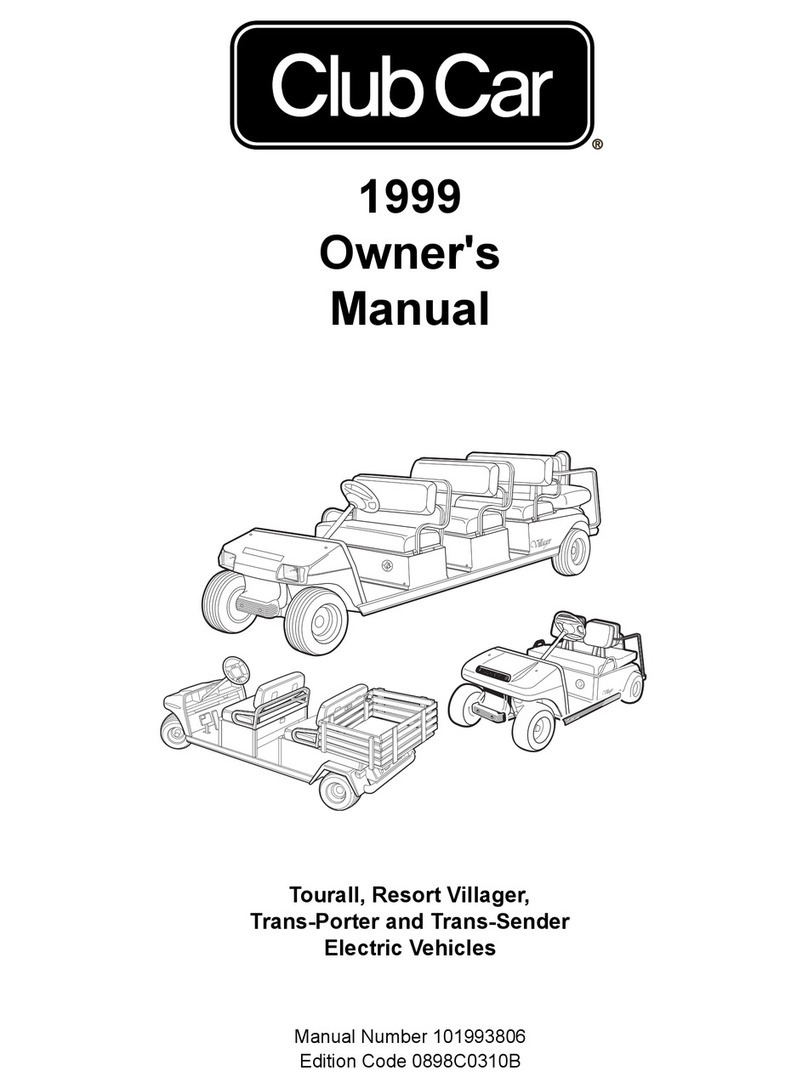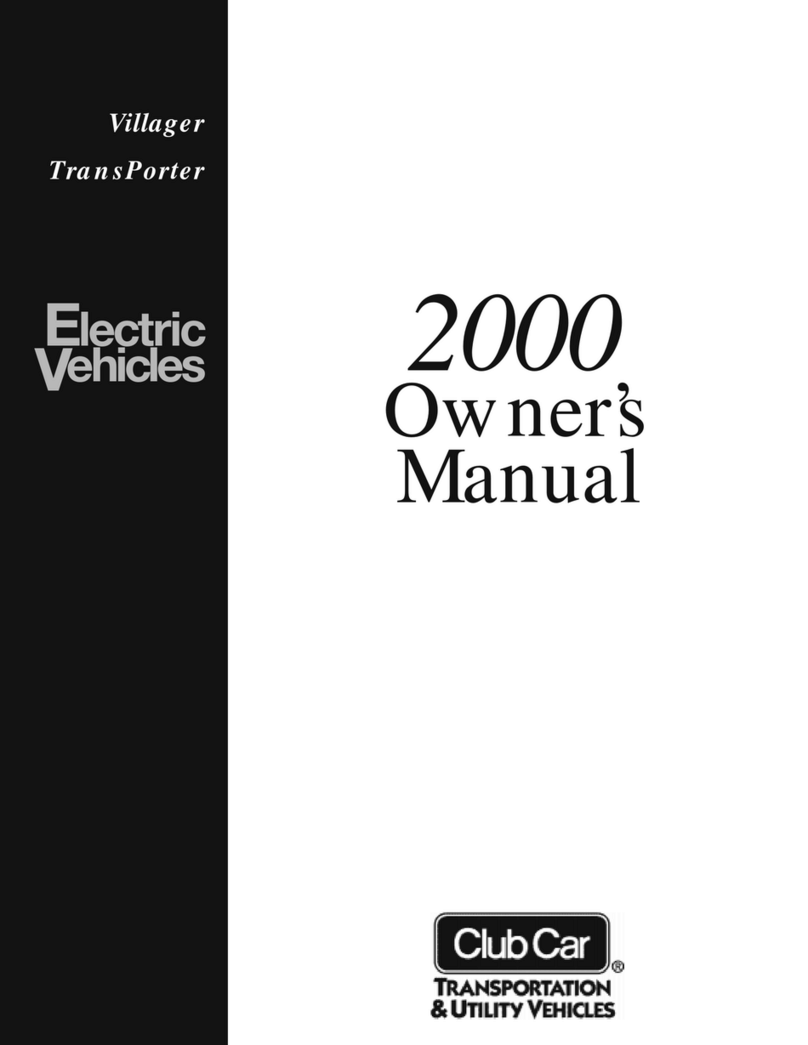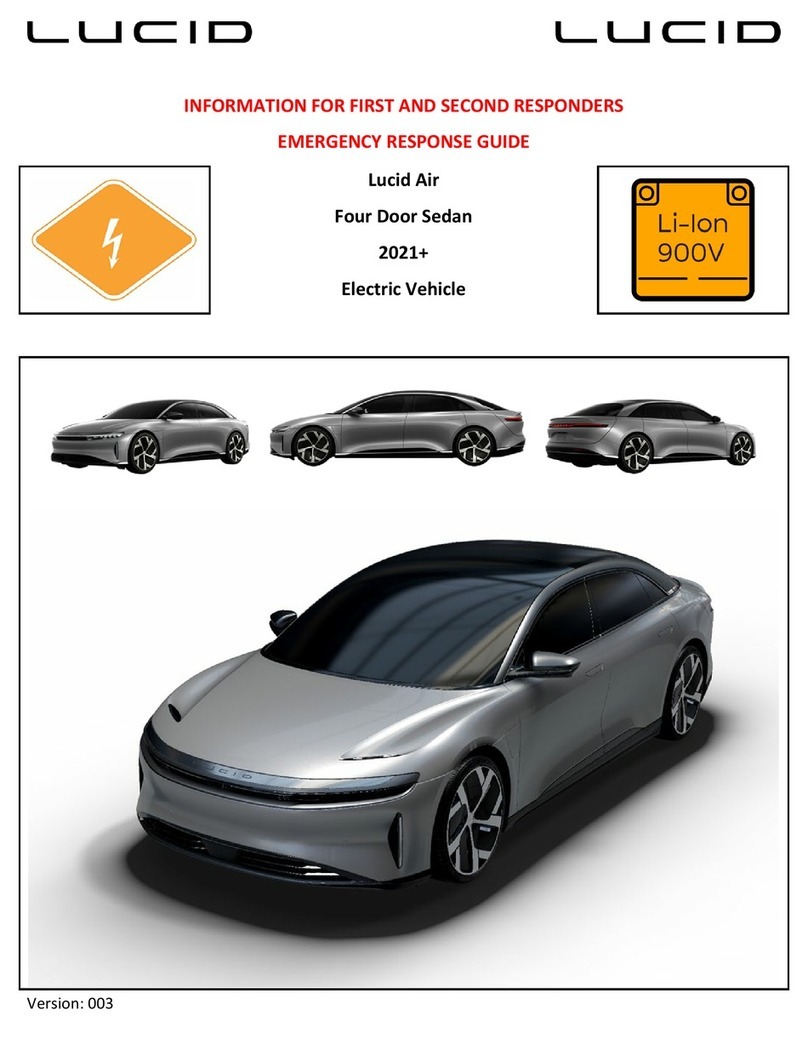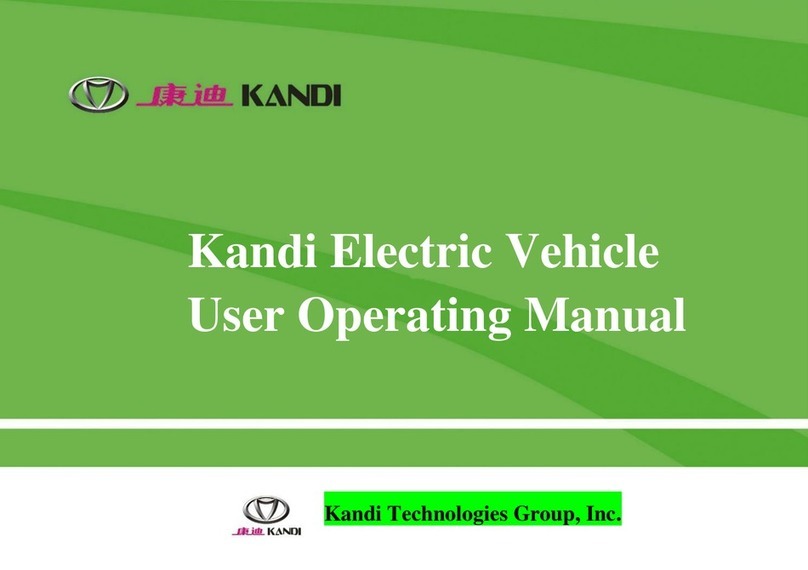Star EV Stalker 4x4 Instruction Manual


Star Electric Vehicles
Owner’s Manual, Safety Guide,
and Warranty Information
Electric Vehicles
Star Stalker 4x4
Star Electric Vehicles reserves the right to make design changes without obligation, to make these changes on units previously
sold and the information contained in this manual is subject to change without notice.
Star Electric Vehicles is not liable for errors in this manual or for incidental and consequential damages that result from the use
of the material in this manual.

3
Notes
Thank you for purchasing a Star electric vehicle.This manual is designed to provide you with a basic
understanding of the features and operation of this vehicle.
Included in this manual:
•Important Safety Information
•Basic maintenance and inspection procedures.
•Information about special techniques and skills needed to ride your Star electric vehicle.
•Warranty Information
For your safety:
•Read this manual carefully and completely before operating your vehicle.
Make sure you understand all instructions.
•Take special notice of warning and caution labels on the vehicle.
•Only operate a Star electric vehicle with proper training or instruction.
• Operators should have a valid motor vehicle license.
• No one under 16 years of age should operate a Star electric vehicle.

4
Table of Contents
Notes 3
Table of Contents 4
General Information 5-8
Operating Instructions
Maintenance
Battery Storage
Charger Operating Instructions
Routine Maintenance Guide
Specifications 9
Safety 10-14
Control Functions 15
Riding the Vehicle 16-29
Proper Instruction 16
Age Recommendation 17
During Operation 17
Alcohol and Drug Use 18
Pre-Operation Checks 18
Tires and Tire Pressure 19
Speed 19
Loading and Accessories 20
SeatBelts 20
Wheelies and Jumping 21
Modifications 21
Road Restrictions 22
Terrain 22-23
Visibility 23
Climbing Uphill 24
Crossing and Turning on Hills 24-25
Dismount 25
Riding Downhill 25-26
Crossing a Slope 26
Crossing Shallow Water 27
Rough Terrain 28
Sliding and Skidding 28-29
Warranty Information 30-31

5
General Information
This guide is provided to assist the owner or operator of this Star product in the safe operation and maintenance of
the vehicle.
Operating Instructions
1) Make sure only responsible drivers operate this vehicle. Operators should have a valid motor vehicle license.
No one under 16 years of age should be allowed to operate the vehicle.
2) Vehicle must be properly maintained in order to insure safe operating condition.
3) The operator of the vehicle should follow all applicable driving rules, regulations, and restrictions.
4) Reduce speed when making sharp turns and when traveling:
a. In wet areas
b. In blind spots
c. Along loose terrain
d. On uneven roads
e. In traffic with other vehicles
f. Near pedestrian areas
5) When parking vehicle:
a. Apply Park Brake
b. Move Forward/Reverse switch to “Neutral” position
c. Turn key to “Off” position
Maintenance
If the owner of this Star electric vehicle is not skilled, experienced, or capable of performing maintenance to
the vehicle, he or she is encouraged to seek assistance to prevent injury to himself/ herself or damage to the
vehicle.
In order to keep your electric vehicle in the safest, most reliable condition, periodic maintenance should
begin at purchase:
1) Star Eelectric Vehicles recommends that a qualified maintenance/ repair dealer perform all maintenance and repairs.
2) Vehicle must be disabled before performing maintenance:
a. Apply Park Brake
b. Move Forward/Reverse switch to “Neutral” position
c. Turn key to “Off” position
3) Replace all safety and warning labels on the vehicle that become damaged or missing.
4) Test drive the vehicle after maintenance is performed or repairs are made.
5) Use wheel chocks and jack stands when lifting the vehicle.
6) Use proper tools when performing maintenance or repairs to the vehicle.
7) Replacement parts are available from your local Star Electric Vehicle dealer. For best performance and safety, use only
factory replacement parts.
8) Star Electric Vehicles recommends that you keep records of all maintenance and repairs.

6
General Information
Battery Storage
Your Star Electric Vehicle is equipped with lead acid batteries. All batteries will self-discharge over time.
The rate of self-discharge varies depending on the ambient temperature and the age and condition of the batteries.
A fully charged battery will not freeze in winter temperatures unless the temperature falls below -75° F (-60° C).
For winter storage, the batteries must be clean, fully charged and disconnected from any source of electrical drain.
As with all electric vehicles, the batteries should be checked and recharged as required or at a minimum of 30-day
intervals.
Charger Operating Instructions
1) Always use a grounded outlet. If using an extension cord, be sure and use a grounded 3-wire 12 AWG cord to avoid
excessive voltage drops.
2) The charger will then turn on and experience a short LED indicator self-test for approximately 2 seconds. If connected to a
battery pack, a trickle current will be applied to the charger until a minimum voltage is reached. If charger is waiting to be
connected to a battery pack and being used in an off-board application, the charging algorithm number will be displayed
for approximately 11 seconds and then display an under-voltage fault (the fault will disappear when plugged into the
battery.)
3) When a minimum battery voltage has been detected, charger will enter the bulk charging constant-current stage. The
length of charge will vary depending on how large and how depleted the battery pack is, the ambient temperature, and the
input voltage. If the ambient temperature is too high, charge power will be reduced to maintain a maximum interval
temperature. If the input AC voltage is low, charge power will be reduced to avoid high input currents.
4) At the time the battery is at approximately 80% state of charge, the bulk stage is then completed and an >80% charge
notification is given. In the next phase, known as the absorption or constant-voltage phase, the last 20% of charge will be
returned to the battery. If the vehicle requires immediate usage, charging could be terminated at this point. However, it is
recommended to wait for 100% charge notification to ensure maximum battery capacity and life.
5) A low current “finish-charge” is lastly applied to return and maintain capacity.
6) The battery is then completely charged. You may now unplug the charger from AC power. If kept plugged in, the charger
will automatically restart another complete charge cycle if the voltage drops below a minimum voltage or 30 days has
passed.
7) If faults occurred at anytime during the charging process, a fault notification is given by flashing RED with corresponding
code. Some errors are serious and may require human intervention to fix the problem and then reset the charge by
disconnecting AC power for at least 15 seconds. Others may automatically recover when the fault condition is eliminated.
To indicate which error occurred, a fault notification will flash RED a number of times, stop, and then repeat.
[1 FLASH] Battery Voltage High: auto-recover
[2 FLASH] Battery Voltage Low: auto-recover
[3 FLASH] Charge Timeout: the charge failed to complete in the allotted time. This might indicate a problem with the
battery pack, or that the charger output was reduced due to high ambient temperatures.
[4 FLASH] Check Battery: battery pack could not be trickled charged to the minimum level required for initial charge. May
indicate one or more cells in the battery pack are damaged or shorted.
[5 FLASH] Over-Temperature: auto-recover. Charger has shutdown because of high internal temperature. Typically
indicates no sufficient airflow for cooling.
[6 FLASH] Fault: an internal fault has been detected. After disconnecting AC power for at least 15 seconds, if Fault 6 is
again displayed, the charger must be taken to a qualified service depot.

7
General Information
Owner’s Routine Maintenance Guide
1) When do I charge my Electric Vehicle?
a. Your Electric Vehicle is equipped with lead acid batteries. These batteries have no memory.
However, it is recommended to opportunity charge these batteries even after minimal use.
b. When the red light begins to blink on the dashboard, you have approximately 1-2 miles of usage left.
Charging the vehicle will take approximately 10-12 hours depending on the state of discharge.
c. Note: It is normal for your onboard charger’s operating temperature to be quite warm. This charger is
fin cooled, not fan cooled. The best way to charge your electric vehicle is to open the front seat
or prop in the open position to help dissipate the heat created by charging the vehicle.
2) How do I charge my Electric Vehicle?
a. Your electric vehicle is equipped with an onboard charger that is multiple rated and operates on a
standard single pole 15-Amp breaker in applicable mode.
b. This charger has a pigtail plug, which you attach to the supplied AC cord and then plug into the wall
outlet.
3) How will I know when my unit is completely charged?
a. Your onboard charger unit has an LED light that indicates completion of battery charge. A green light
display indicates a full charge. Your onboard charger will automatically shut off after charging is
complete. (Refer to Page 6 of your Owner’s Manual for more details related to your onboard charger.)
4) What is the purpose of the toggle switch on the dash?
a. This button turns the reverse buzzer on or off.
5) What tire pressure should I keep in my tires?
a. See manufacturer’s recommended inflation pressure located on the tire sidewall.
6) What parts of my electric vehicle are not covered under the 1-year manufacturer warranty?
a. Tires and lighting bulbs.
b. Any and all damages to unit due to incorrectly performed maintenance and charging procedures.
c. Pick up and delivery of vehicle.
d. Vehicles used for commercial purposes carry a one-year warranty.
7) How do I clean my Electric Vehicle?
a. Turn the key to the OFF position and remove before washing the vehicle.
b. Wash with soap and water. All parts of vehicle can be hosed off including battery terminals. Be sure to
run the car after washing as the brakes may lock up if car is left to sit in place.

8
General Information
c. Do not concentrate water stream in location of black box located in the center of the battery box. This is
where the controller and electronics are located in your vehicle.
9) When should I do routine maintenance on my vehicle?
a. Disc brake pads should be visually inspected periodically and should be changed when the minimum
pad thickness is reached by a certified technician.
b. Tire care is basic. Keep tires clean and use tire care products as needed.
10) Any other technical questions which may arise concerning operating procedures and/or maintenance procedures
can be answered by contacting your local Star electric vehicle dealer.

9
Specifications
Star Stalker 4x4
Weight 1625 lbs. / 738 kg
Load Capacity 1100 lbs. / 500 kg
Height 83.5 in. / 212 cm
Tires (4-ply) 23” x 10.5” x 12”
Tire Pressure See tire sidewall for manufacturer’s recommendation
Lights 55-watt Halogen
Brakes 4 Wheel Hydraulic Disc Brakes
Electric voltage 72-volt D.C.
Six 12-volt deep cycle AGM batteries
#00 gauge Copper wiring
Motor 5KW AC
Forward/Reverse Switch Solid state rocker switch
Speed Controller 550-amp solid state AC
Speed 18 mph
Charger Fully automatic.
Specifications are subject to change as we continue to build you a better product!

10
Safety
General Safety Information
This guide is provided to assist the owner or operator of this Star electric vehicle in the maintenance and safe
operation of the vehicle. The warnings in this manual are not a replacement for good common sense and safe
driving practices. Your electric vehicle is designed and manufactured for off-road use. It does not conform to
Federal Motor Vehicle Safety Standards and is not equipped for operation on public streets unless equipped
with LSV package option. (More information on the LSV package option is available through your local Star Electric
Vehicle Dealer.) Operators of the electric vehicle should have a valid motor vehicle license. No one
under 16 years of age should be allowed to operate a Star electric vehicle.
Operating Safety
1) Always use your Star electric vehicle in a responsible manner and maintain the vehicle in safe
operating conditions.
2) Always read and observe all warnings and operation instruction labels affixed to the Star electric
vehicle.
3) Always follow all safety rules established in the area where you are operating the electric vehicle.
4) Always use extreme caution when making sharp or blind turns.
5) Always apply brake to control speed on steep grades.
6) Always use extreme caution when traveling:
a. In wet areas
b. In blind spots
c. Along loose terrain
d. On uneven roads
e. In traffic with other vehicles
f. Near pedestrian areas.
Notes, Cautions, and Warnings
The following notations indicate important information. Failure to follow the warnings contained in this manual could
result in serious injury or death.
NOTE:Condition that should be observed. This provides key information that
makes procedures easier and clearer.
CAUTION:Condition that may result in damage to the vehicle. Special
precautions must be taken to avoid damage to the vehicle.
! WARNING !
WARNING:Hazardous condition that could result in severe injury or death to
the vehicle operator, a bystander, or a person inspecting or repairing the
vehicle.

11
Safety
General Safety Practices
Steep Grade: ! WARNING !
In areas where steep grades exist, vehicle operations should be restricted to the designated vehicle pathways where
possible, and shall be identified with a suitable warning giving the following information: “Warning, steep grade,
descend slowly with one foot on the brake.”
Wet Areas: ! WARNING !
Wet grassy areas may cause a vehicle to lose traction and may affect stability. Wet areas should be chained or
roped off to prevent vehicle operations or be identified by a suitable warning not to operate vehicles in this area due
to wet terrain.
Sharp Turns, Blind Corners, and Bridge Approaches: ! WARNING !
Sharp turns, blind spots, bridge approaches, and other potentially hazardous areas shall be either chained or roped
off to prevent vehicle operations or identified with a suitable warning to the operator of the nature of the hazard and
stating the proper precautions to be taken to avoid the hazard.
Loose Terrain: ! WARNING !
Loose terrain may cause a vehicle to lose traction and may affect stability. Areas of loose terrain should be repaired
if possible, or chained or roped off to prevent vehicle operation, or identified by a suitable warning to operators not to
operate vehicles in this area due to loose terrain or possible hazardous conditions.
Pedestrian Areas: ! WARNING !
Areas where pedestrians and vehicles interfere shall be avoided whenever possible by rerouting the vehicle traffic or
the pedestrian traffic to eliminate the interference. If elimination of the interference is not possible or is highly
impractical, signs shall be erected warning pedestrian traffic and to drive slowly and use extreme caution.
Ventilation: ! WARNING !
During the charging process, we recommend lifting the seat bottom to allow more air flow and reduce heat build up.

12
Safety
Read and understand all labels located on this vehicle. For any questions on any of the information, contact a Star
Electric Vehicle representative for clarification.
Always replace any damaged or missing labels.
On steep hills it is possible for vehicles to coast at greater than normal speeds encountered on a flat surface. To
prevent loss of vehicle control and possible serious injury, speeds should be limited to no more than the maximum
speed on level ground. Limit speed by applying the service brake.
Catastrophic damage to the drive train components due to excessive speed may result from driving the vehicle
above specified speed. Damage caused by excessive speed may cause a loss of vehicle control and is costly. This
is considered abuse and will not be covered under warranty.
Use extra caution when towing the vehicle.
If the vehicle is to be used in a commercial environment, signs should be used to warn of situations that could result
in an unsafe coasting condition.
Keep this manual as part of the permanent service record in case the vehicle should be resold.

13
Safety
This Star electric vehicle is intended for off-road use only. The owner should check local and other
applicable laws and regulations before operating.
SEVERE INJURY OR DEATH can result if you do not follow these instructions:
•Read this entire manual and all labels carefully and follow the operating procedures described.
•Only operate a Star electric vehicle if you have had proper training or instruction.
•Follow these age recommendations:
No one under 16 years of age should operate a Star electric vehicle or be left without adult supervision.
•Be weary of passengers or pedestrians.
•Do not operate a Star electric vehicle on a highway.
•Do not consume alcohol or drugs before or while operating this machine.
•Never operate at speeds too fast for your skills or the outdoor conditions. Always operate at a speed that is
suitable for the terrain, visibility and operating conditions, and your experience.
•Never attempt wheelies, jumps, or other stunts.
•Inspect your vehicle every time it is used to make sure it is in safe operating condition. Follow the inspection
and maintenance procedures and schedules described in this manual.
•Always keep both hands on the wheel during operation.
•Always drive at slower speeds and be cautious when operating on unfamiliar terrain. Be alert to changing
terrain conditions at all times when operating a Star electric vehicle.
•Do not operate your vehicle on excessively rough, slippery or loose terrain until you have learned and practiced
the skills necessary to control the vehicle on such terrain. Be especially cautious of these kinds of terrain.
•Always follow proper procedures for turning as described in this manual. Practice turning at low speeds before
attempting to turn at faster speeds. Do not turn at excessive speeds.
•Do not operate the vehicle on hills too steep for the vehicle or for your ability. Practice on smaller hills before
attempting larger ones.
•Always follow safety procedures for climbing hills. Check the terrain carefully before you start up any hill. Never
climb hills with excessively slippery or loose surfaces. Shift your weight forward. Never open the throttle
suddenly or make sudden gear changes. Never go over the top of a hill at high speed.
•Always follow safety procedures for going down hills and for braking on hills. Check the terrain carefully before
you start down any hill. Shift your weight backward. Never go down a hill at high speeds. Avoid going down a
hill at an angle that could cause the vehicle to lean sharply to one side. Go straight down the hill where
possible.

14
Safety
•Always follow proper procedures for crossing the side of a hill as described in this manual. Avoid hills with
excessively slippery or loose surfaces. Shift your weight to the uphill side of the vehicle. Never attempt to turn
the vehicle around on any hill until you have mastered the turning technique on level ground. Avoid crossing the
side of a steep hill if possible.
•Use proper procedures if you stall or roll backwards when climbing a hill. To avoid stalling, use proper gear and
maintain a steady speed when climbing a hill. If you stall or roll backwards, follow the special procedure for
braking. Dismount on the uphill side or to a side if pointed straight uphill. Turn the vehicle around and remount.
•Always check for obstacles before operating in a new area.
•Never attempt to operate over large obstacles, such as large rocks or fallen trees.
•Be careful when skidding or sliding. Learn to safely control skidding or sliding by practicing at low speeds and
on level, smooth terrain. On extremely slippery surfaces, such as ice, go slowly and be very cautious in order to
reduce the chance of skidding or sliding out of control.
•Never operate a Star electric vehicle in fast flowing water or excessively deep waters. Contact with water
may affect the batteries. Remember that wet brakes may have reduced stopping ability. Test your brakes after
leaving water. If necessary, apply them several times to let friction dry out the linings.
•Always use the size and type tires specified in this manual.
•Always maintain proper tire pressure as described in this manual.
•Never modify a Star electric vehicle through improper installation or use of accessories.
•Never exceed the stated load capacity for a vehicle. Cargo should be properly distributed and securely
attached. Reduce speed and follow sound procedures for carrying cargo or pulling a trailer. Allow greater
distance for braking.

15
Control Functions
Main Switch
Functions of the respective switch positions are as follows:
ON:
Engine can be started only at this position and the headlight and taillight come on when the light switch is on.
OFF:
All electrical circuits are switched off. The key can be removed in this position.
Entering the Vehicle
All passengers must be seated with seat belt properly fastened at all times while the Star electric vehicle is in
use.
Turning the Vehicle On
Hold brake, switch on key switch and select the desired direction (Forward or Reverse).
Driving the Vehicle
After selecting the desired selection, apply foot brake. Release Park Brake. Turn key to the “On” position, release
foot brake, and accelerate smoothly. Always be aware of surrounding terrain and use caution. Judge speed
accordingly. Be cautious when encountering loose or wet terrain. Do not attempt steep grades. To release Park
Brake, depress Park Brake pedal and release.
Stopping the Vehicle
Slow down by pushing down the foot brake pedal. To stop, release accelerator pedal and apply foot brake pedal. To
engage Park Brake, depress Park Brake until locked.
Turning the Vehicle Off
After applying the Park Brake, switch the key to the OFF position; switch the direction selector to Neutral (N).
Exiting the Vehicle
Once the vehicle has come to a complete stop, the Park Brake is applied, the key switch is turned to the OFF
position, and the direction selector is switched to Neutral, all passengers can carefully exit the vehicle. Never
attempt to exit the vehicle while it is still moving. This could lead to severe injury.
Storing the Vehicle
Store the Star electric vehicle with Park Brake applied, key switch in the OFF position, and the switch
selector in the Neutral (N) position.

16
Riding the Vehicle
Ride With Care and Good Judgment
Get Training if You Are Inexperienced
This Star electric vehicle should only be used by experienced operators with valid motor license. This vehicle requires
special skills obtained through practice. Take your time to fully learn techniques before attempting
more difficult maneuvers.
You should familiarize yourself with the operation of the vehicle to achieve the skill necessary to enjoy riding safely.
Be sure you have read this entire guide and understand the operation of the controls before you begin to ride. Pay
particular attention to the safety information. Please also read all caution and warning labels on your Star
electric vehicle.
Beginners should get training from a certified instructor. Become familiar with this vehicle at slow speeds first, even
if you are an experienced operator. Do not attempt to operate at maximum performance until you are totally familiar
with the vehicle’s handling and performance characteristics.
! WARNING !
Proper Instruction
Potential Hazard
Operating this vehicle without proper instruction
What Can Happen
The risk of an accident is greatly increased if the operator does not know how to operate
the vehicle properly in different situations and on different types of terrain.
How to Avoid the Hazard
Beginning and inexperienced operators should complete a certified training course for
the vehicle.
Riding your vehicle requires skills acquired through practice over a period of time. Take the
time to learn the basic techniques well before attempting more difficult maneuvers.

17
Riding the Vehicle
! WARNING !
Age Recommendation
Not recommended for children under 16 years of age.
Potential Hazard
Failure to follow the age recommendations for this vehicle
What Can Happen
Use by children of vehicles that are not recommended for their age can lead to severe
injury or death of the child.
How to Avoid the Hazard
A child under 16 should never operate a Star electric vehicle.
! WARNING !
During Operation
Always keep your feet inside the vehicle during operation. Otherwise, your feet may contact
the rear wheels.
Potential Hazard
Removing hands from steering wheel or feet from inside the vehicle during operation
What Can Happen
Removing even one hand or foot can reduce your ability to control the vehicle or could
cause you to lose your balance and fall out of the vehicle. If you remove a foot from
inside the vehicle, your foot or leg may come into contact with the rear wheels or objects
outside the vehicle, which could injure you or cause an accident.
How to Avoid the Hazard
Always keep both hands on the steering wheel and both feet inside the vehicle during
operation.

18
Riding the Vehicle
! WARNING !
Alcohol and Drug Use
Do not operate after consuming alcohol or drugs. Operator’s performance capability is
reduced by the influence of alcohol or drugs.
Potential Hazard
Operating this vehicle after consuming alcohol or drugs
What Can Happen
Could seriously affect your judgment.
Could cause you to react more slowly.
Could affect your balance and perception.
Could result in an accident.
How to Avoid the Hazard
Never consume alcohol or drugs before or while driving this vehicle.
! WARNING !
Pre-Operation Checks
Always perform Pre-Operation checks before riding for safety and proper care of the vehicle.
Potential Hazard
Failure to inspect the vehicle before operating
What Can Happen
Increases the possibility of accident or equipment damage.
How to Avoid the Hazard
Always inspect your vehicle each time you use it to make sure the vehicle is in safe
operating condition.

19
Riding the Vehicle
! WARNING !
Tires and Tire Pressure
Potential Hazard
Operating this vehicle with improper tires, or with improper or uneven tire pressure
What Can Happen
Use of improper tires on this vehicle, or operation of this vehicle with improper or uneven
tire pressure, may cause loss of control, increasing your risk of an accident.
How to Avoid the Hazard
Always use the size and type of tires specified in this guide for this vehicle.
Always maintain proper tire pressure per manufacturer’s recommendation on tire’s
sidewall.
! WARNING !
Speed
Do not operate at speeds too fast for your skills or the conditions.
Potential Hazard
Operating this vehicle at speeds too fast for your skills or the conditions
What Can Happen
Increases your chances of losing control of the vehicle, which can result in an accident
How to Avoid the Hazard
Always go at a speed that is proper for the terrain, visibility and operating conditions,
and your experience.

20
Riding the Vehicle
! WARNING !
Loading and Accessories
Use extra caution when riding the vehicle with additional loads, such as accessories or
cargo. The vehicle’s handling may be adversely affected. Reduce your speed when adding
additional loads.
Potential Hazard
Overloading this vehicle or carrying or towing cargo improperly
What Can Happen
Could cause changes in vehicle handling which could lead to an accident
How to Avoid the Hazard
Never exceed the stated load capacity for this vehicle.
Cargo should be properly distributed and securely attached.
Reduce speed when carrying cargo or pulling a trailer.
Allow greater distance for braking.
Always follow instructions for carrying cargo or pulling a trailer.
! WARNING !
Seat Belts
Potential Hazard
Failure to properly wear seat belt while in the Star electric vehicle
What Can Happen
Failure to properly wear seat belt can lead to potential injury or death of passenger.
How to Avoid the Hazard
Each passenger must always wear a seat belt while in the Star electric vehicle.
Table of contents
Other Star EV Electric Vehicle manuals
